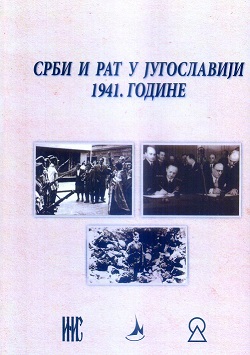Идеолошка основа злочина Независне Државе Хрватске 1941.
The Ideological Basis of Crimes of the Independent State of Croatia in 1941
Author(s): Jovan Mirković
Subject(s): Civil Society, History of ideas, Criminology, Victimology, WW II and following years (1940 - 1949), Fascism, Nazism and WW II, Peace and Conflict Studies
Published by: Institut za noviju istoriju Srbije
Keywords: Independent State of Croatia (NDH/ISC); ideology of Ustasha; Genocide; crimes in direct terror; crimes in the state institutions;
Summary/Abstract: The newly-proclaimed Croatian state in April 1941 was based on the ideology of the Ustasha movement that was founded on racist and extremely nationalist policy with the aim of creating a “purely Croatian living-space” that would make possible the existence of the “pure Croatian nation”. The precondition for such tendencies was physical extermination of the Serbs and the Jews who were declared the “greatest enemies of the Croatian people” for whom “there was no place in Croatia”. They were joined by the Gypsies, as a non-Aryan inferior race. In order to achieve these goals “internal purification” was also needed, i.e. it was also necessary to destroy all those Croat and Muslim elements designated as traitors due to their “un-Croatian behavior” who were perceived as “a blemish on the body of the pure Croatian nation”. The reaction to the entry of German troops into Zagreb and the enthusiastic greeting with which they met, show that at the time of the aggression of the Fascist powers on Yugoslavia the ideology of the Ustasha movement was in keeping with prevailing ideological and religious attitude of large part of the Croatian people. The goals, the way of organizing and performing the activities of the Ustasha organization prove its terrorist character. Crimes against the Serbian population (as the factor of disturbance) and against the Jews and the Gypsies (as non-Aryans) were committed not because these weren’t loyal to the new government and because of the stability of the new state, but because of the ideological bases on which that state was build. This was shown by public statements and the propaganda activities of the exponents of this ideology (the Ustasha) and by the government through legislation, as well as by actions of all state organs – the police, the military, the judiciary, the administration – primarily through physical destruction of groups or through creation of conditions condemning a group to biological destruction. This is particularly visible from the analysis of the chronology of crimes committed during the first days of the existence of the ISC, that is in a period when there was no organized resistance as well as by the analysis of statistical data of the name-census of the war victims that has been revised so far. From the analysis of the statistical data and categories of the name census of the victims it is evident that the Independent State of Croatia ever since its proclamation and throughout the war committed systematic crime of genocide with the intention of destroying some ethnic, national and religious groups – Orthodox Serbs, the Jews and the Gypsies – which is particularly visible in the analysis of the 1941 data. Genocidal character of the crimes during the first days of the ISC’s existence can be observed on examples of mass liquidations in which political or military capability of a group to oppose the regime played no role whatsoever. On the contrary, mass liquidations of the whole population took place – of men, women, children and the aged. Exactly the analysis of the manifest intent and actions in 1941 show that the crime , the most severe form of crimes against humanity – the genocide (as defined afterwards) was in-built in the very foundations of the newly-founded state and its ideological basis.
Book: Срби и рат у Југославији 1941. године
- Page Range: 375-390
- Page Count: 16
- Publication Year: 2014
- Language: Serbian
- Content File-PDF

